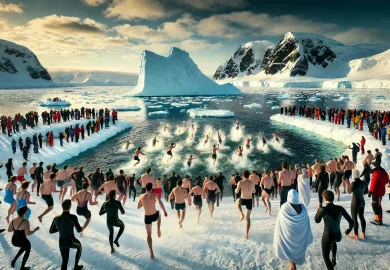
Antarctica is a land of extremes, where temperatures can plummet to bone-chilling lows, and the environment demands the utmost resilience from those who inhabit it. Among the many unique traditions that have developed in this frozen continent, none is as daring or as emblematic of the human spirit as the 300 Club. This exclusive club is not a formal organization but rather a rite of passage, a test of bravery, and a testament to the adventurous souls who dare to push the limits of their physical and mental endurance.
The 300 Club is a tradition that takes place at the Amundsen-Scott South Pole Station, where temperatures can dip to -100°F (-73°C) or lower during the long, dark winter. The name of the club comes from the temperature difference that participants experience: they first endure the extreme heat of a 200°F (93°C) sauna before stepping outside into the Antarctic night, where temperatures can be as low as -100°F, creating a staggering 300°F difference.
The Origins of the 300 Club: A Historical Perspective
The tradition of the 300 Club dates back to the early days of scientific exploration at the South Pole. The first recorded instance of this daring feat occurred in the 1950s, during the International Geophysical Year (IGY), a period of scientific research that marked the beginning of modern exploration in Antarctica. The researchers and support staff stationed at the South Pole faced isolation, extreme weather conditions, and the mental challenges of living in one of the most inhospitable environments on Earth.
To combat the monotony and psychological strain of the long Antarctic winter, the men and women at the station began to develop unique traditions and rituals. The 300 Club emerged as one of these rituals, a way for the hardy souls at the South Pole to bond, test their limits, and create a shared experience that would be remembered long after they returned to more temperate climates.
Since its inception, the 300 Club has become a symbol of the camaraderie and resilience of those who live and work in Antarctica. It is not an official event, but rather an informal challenge that participants undertake voluntarily, often during the coldest months of the year when the temperature difference between the sauna and the outside air is at its greatest.
How to Join the 300 Club: The Process Explained
Joining the 300 Club is not for the faint of heart. The process begins with participants spending time in a sauna heated to a scorching 200°F (93°C). This is no ordinary sauna session; the goal is to raise the body temperature as much as possible, allowing participants to withstand the shock of the frigid air outside.
After spending up to 10 minutes in the sauna, participants strip down to minimal clothing, usually just a pair of shorts or a swimsuit. Then, they make the brave dash outside, often in the dark, as the sun does not rise during the Antarctic winter. The run covers a short distance, typically a loop around the ceremonial South Pole marker, which is located a few hundred feet from the station.
The entire experience is surreal: the intense heat of the sauna followed by the biting cold of the Antarctic night creates a sensation that is both exhilarating and terrifying. Participants often describe the feeling as one of complete sensory overload, with the body struggling to process the extreme temperature change. The run is quick, usually lasting only a minute or two, but it leaves a lasting impression on those who complete it.
Once the run is finished, participants rush back inside to warm up, often returning to the sauna to thaw out before dressing in warmer clothes. The entire event is typically celebrated with a sense of accomplishment and camaraderie, with participants sharing stories and photos of their experience.
The Physical and Psychological Challenges of the 300 Club
Participating in the 300 Club is not just a test of physical endurance; it is also a mental challenge. The extreme cold of Antarctica can be dangerous, even life-threatening, and participants must be aware of the risks involved. Frostbite, hypothermia, and other cold-related injuries are real dangers, and participants must take precautions to minimize these risks.
The physical challenge begins in the sauna, where the intense heat can be difficult to endure. The body responds to the heat by sweating profusely, and the heart rate increases as the body works to cool itself down. This can be exhausting, and participants need to be mindful of their limits to avoid overheating.
The real test comes when participants step outside. The sudden drop in temperature can cause the body to go into shock, and the cold air can make breathing difficult. The skin and extremities, exposed to the freezing temperatures, can quickly begin to numb, increasing the risk of frostbite. Participants must move quickly but carefully to avoid injury, and they must be prepared to retreat indoors at the first sign of danger.
Psychologically, the 300 Club requires a high level of mental toughness. The thought of stepping outside into -100°F temperatures, wearing little more than a swimsuit, can be daunting. It takes courage to push through the fear and discomfort and to trust that the body will survive the experience. The mental fortitude required to complete the challenge is part of what makes the 300 Club so respected among those who live and work in Antarctica.
The 300 Club: A Symbol of Antarctic Resilience
For those who participate in the 300 Club, the experience is more than just a physical challenge; it is a symbol of resilience and determination. Antarctica is a place where survival depends on the ability to adapt to extreme conditions, and the 300 Club is a way for the people who live and work there to demonstrate their ability to thrive in this harsh environment.
The tradition of the 300 Club has become a badge of honor among the South Pole community. It is a way for people to connect with each other and to share in the unique experiences that come with living in one of the most remote and inhospitable places on Earth. The 300 Club is also a reminder of the importance of camaraderie and teamwork in Antarctica. The extreme conditions of the continent demand that people work together and support each other, and the 300 Club is a way to reinforce these bonds.
In addition to its symbolic value, the 300 Club is also a testament to the human spirit. The willingness to endure discomfort, to push through fear, and to take on a challenge that few others would dare to attempt is a reflection of the resilience and determination that define the people who live and work in Antarctica. The 300 Club is not just a test of physical endurance; it is a celebration of the adventurous spirit that drives people to explore the unknown and to push the boundaries of what is possible.
Conclusion: The Legacy of the 300 Club in Antarctica
The 300 Club is a unique and enduring tradition that has become an integral part of life at the South Pole. It is a test of courage, endurance, and mental toughness, and it is a symbol of the resilience and determination of those who live and work in Antarctica. For the people who participate in the 300 Club, the experience is a once-in-a-lifetime opportunity to push their limits and to connect with others who share their adventurous spirit.
As Antarctica continues to be a place of scientific exploration and discovery, the 300 Club remains a reminder of the human capacity to adapt and thrive in even the most extreme environments. The tradition is likely to continue for as long as people live and work at the South Pole, inspiring future generations to take on the challenge and to join the ranks of those who have experienced the thrill of the 300 Club.
The legacy of the 300 Club is one of courage, camaraderie, and the enduring human spirit. It is a tradition that embodies the very essence of life in Antarctica, where survival is a daily challenge, and where the people who call this frozen continent home are united by their shared experiences and their unyielding determination to conquer the cold.








